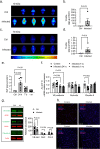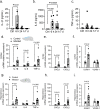Lung infection by Pseudomonas aeruginosa induces neuroinflammation and blood-brain barrier dysfunction in mice
- PMID: 37245027
- PMCID: PMC10223932
- DOI: 10.1186/s12974-023-02817-7
Lung infection by Pseudomonas aeruginosa induces neuroinflammation and blood-brain barrier dysfunction in mice
Abstract
Background: Severe lung infection can lead to brain dysfunction and neurobehavioral disorders. The mechanisms that regulate the lung-brain axis of inflammatory response to respiratory infection are incompletely understood. This study examined the effects of lung infection causing systemic and neuroinflammation as a potential mechanism contributing to blood-brain barrier (BBB) leakage and behavioral impairment.
Methods: Lung infection in mice was induced by instilling Pseudomonas aeruginosa (PA) intratracheally. We determined bacterial colonization in tissue, microvascular leakage, expression of cytokines and leukocyte infiltration into the brain.
Results: Lung infection caused alveolar-capillary barrier injury as indicated by leakage of plasma proteins across pulmonary microvessels and histopathological characteristics of pulmonary edema (alveolar wall thickening, microvessel congestion, and neutrophil infiltration). PA also caused significant BBB dysfunction characterized by leakage of different sized molecules across cerebral microvessels and a decreased expression of cell-cell junctions (VE-cadherin, claudin-5) in the brain. BBB leakage peaked at 24 h and lasted for 7 days post-inoculation. Additionally, mice with lung infection displayed hyperlocomotion and anxiety-like behaviors. To test whether cerebral dysfunction was caused by PA directly or indirectly, we measured bacterial load in multiple organs. While PA loads were detected in the lungs up to 7 days post-inoculation, bacteria were not detected in the brain as evidenced by negative cerebral spinal fluid (CSF) cultures and lack of distribution in different brain regions or isolated cerebral microvessels. However, mice with PA lung infection demonstrated increased mRNA expression in the brain of pro-inflammatory cytokines (IL-1β, IL-6, and TNF-α), chemokines (CXCL-1, CXCL-2) and adhesion molecules (VCAM-1 and ICAM-1) along with CD11b + CD45+ cell recruitment, corresponding to their increased blood levels of white cells (polymorphonuclear cells) and cytokines. To confirm the direct effect of cytokines on endothelial permeability, we measured cell-cell adhesive barrier resistance and junction morphology in mouse brain microvascular endothelial cell monolayers, where administration of IL-1β induced a significant reduction of barrier function coupled with tight junction (TJ) and adherens junction (AJ) diffusion and disorganization. Combined treatment with IL-1β and TNFα augmented the barrier injury.
Conclusions: Lung bacterial infection is associated with BBB disruption and behavioral changes, which are mediated by systemic cytokine release.
Keywords: Blood–brain barrier; Lung infection; Permeability.
© 2023. The Author(s).
Conflict of interest statement
The authors declare that they have no competing interests.
Figures







Update of
-
Lung infection by P. aeruginosa induces neuroinflammation and blood-brain barrier dysfunction in mice.bioRxiv [Preprint]. 2023 Jan 23:2023.01.23.524949. doi: 10.1101/2023.01.23.524949. bioRxiv. 2023. Update in: J Neuroinflammation. 2023 May 27;20(1):127. doi: 10.1186/s12974-023-02817-7. PMID: 36747856 Free PMC article. Updated. Preprint.
-
Lung infection by P. aeruginosa induces neuroinflammation and blood-brain barrier dysfunction in mice.Res Sq [Preprint]. 2023 Jan 30:rs.3.rs-2511441. doi: 10.21203/rs.3.rs-2511441/v1. Res Sq. 2023. Update in: J Neuroinflammation. 2023 May 27;20(1):127. doi: 10.1186/s12974-023-02817-7. PMID: 36778380 Free PMC article. Updated. Preprint.
References
MeSH terms
Substances
Grants and funding
LinkOut - more resources
Full Text Sources
Research Materials
Miscellaneous

